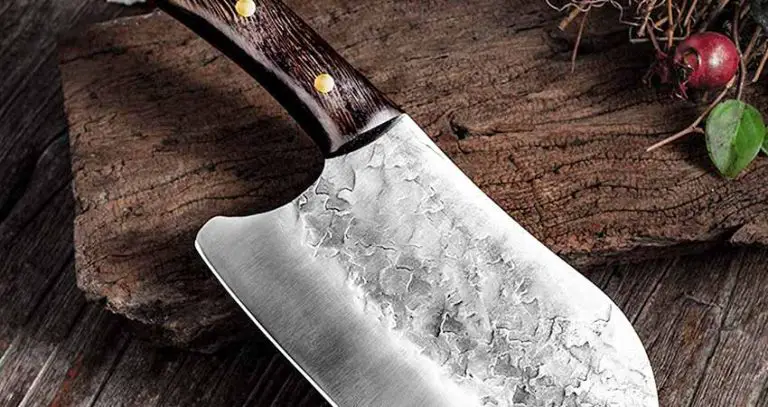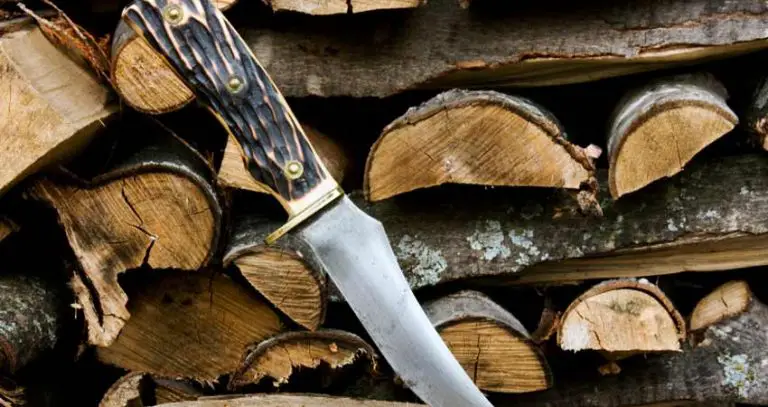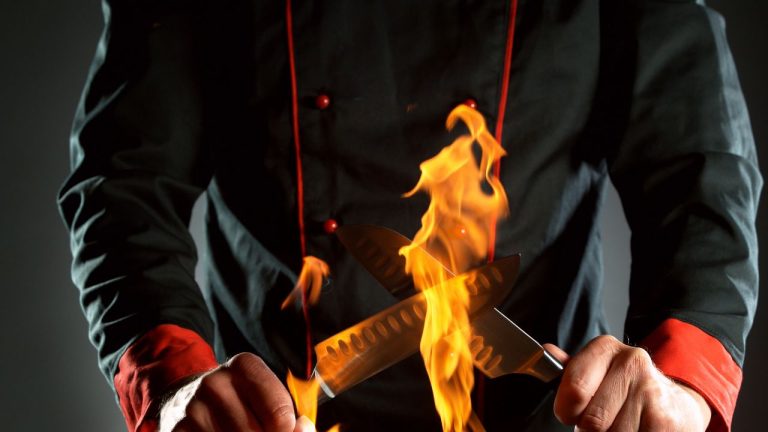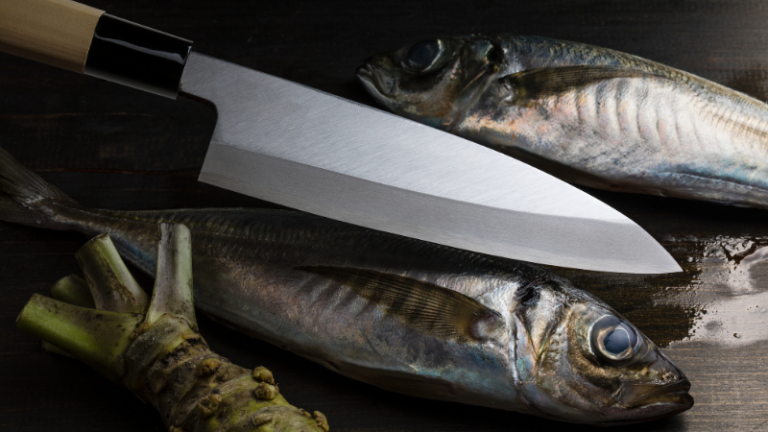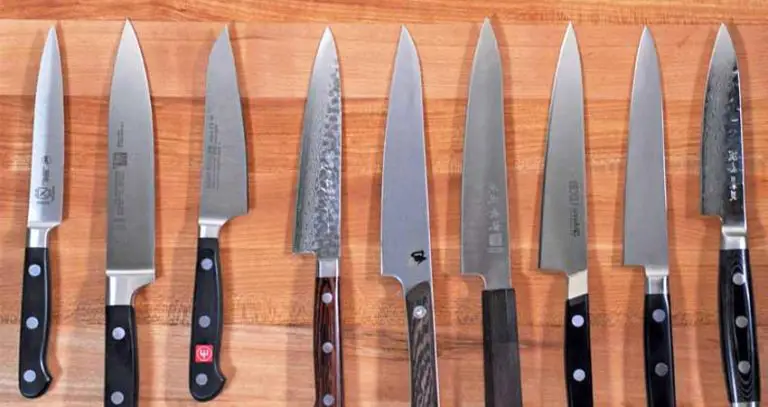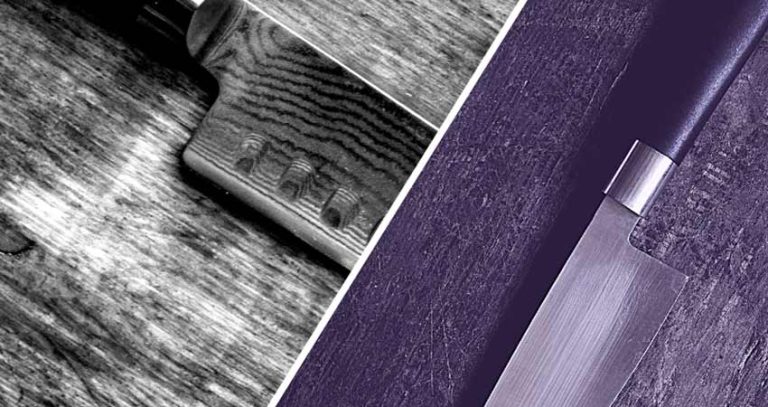How To Use A Santoku Knife? A Step By Step Guide
If you’re wondering, what’s the best knife shape for you? There’s a lot of different answers, but one option that stands out for us is the Santoku Knife.
This is a Japanese-origin, general-purpose kitchen knife that has become universal. It’s now made by pretty much every blacksmith and manufacturer.
What makes this knife so special? The answer is its shape that has a sloped tip that comes down to the cutting board pretty flat.
This allows the knife to make a lot of contact with the cutting object providing the finest slicing, chopping, and dicing.
It’s an extra sharp knife and you may be asking yourself “Is it difficult to use?” Well, it’s not! You’ll soon find this out as we’ll be showing you how to use a Santoku knife on fish, meat, and vegetables in your favorite kitchen!
How To Use A Santoku Knife
The Japanese word Santoku can be translated into “three virtues”. This probably means the three of its functionalities that you can use if for in the kitchen.
These are chopping, slicing, and mincing. Here we’ll be talking about how to use this knife for these specific kitchen tasks along with some general kitchen knife rules.
Hold The Knife Right
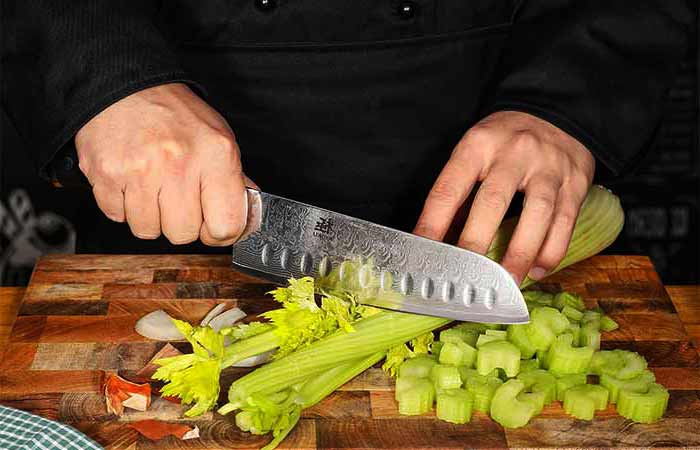
The Santoku Knife comes in a large size (not an intimidating one though) that can tackle almost every job in the kitchen.
But you must be wondering how to hold that? Like most other Japanese Knives, you need to balance that well.
- The “pinch grip” is the best way to hold the knife where you’ve got the middle finger tucked against the finger-guard.
- It’ll allow you to pinch the blade heel with the thumb on one side and the index finger ringlet on the other.
- Make sure to grip it firmly yet gently.
Safe Hand Positions
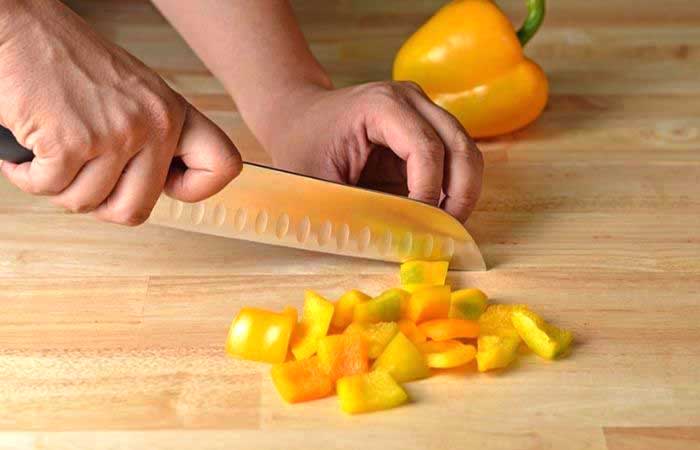
If you’ve your cutting object placed on the cutting board, make sure you’re holding your hands really high. It’ll help you to avoid the heel of the knife coming over your hand and fingers.
- If you’re a righty, you should be holding the left hand in a bit of pinch grip like making a claw.
- This will allow most of your fingers to get tucked away behind the middle finger, keeping the hand as safe as possible while you’re cutting.
- It should feel like you’re running the back of the blade on your finger and also have an idea where the knife is.
How To Chop Using Santoku
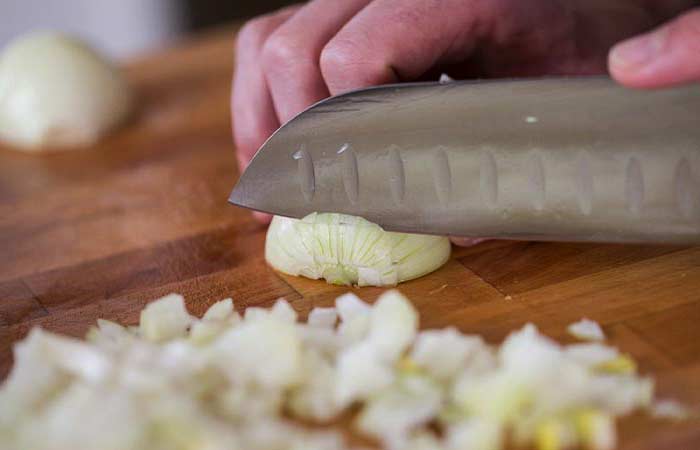
If you want to get above something to cut with the Santoku kitchen knife, it makes the job pretty easy. Because it’s got a bit of a curve with a fairly straight back.
- Instead of using the rock chop technique, the flat edge of the Santoku knife requires you to pick the knife up and aim the tip jet slightly down towards the board.
- You can then continue chopping in a smooth, up-and-down motion while moving the knife a little bit forward and lifting its blade off the board between every cut.
- Make sure to stabilize your cutting surface and the ingredients.
- Once you’re comfortable with the up-and-down technique, you can apply the push-cut technique for faster chopping.
- It will require you to push the ingredients towards the knife blade as you chop along.
How to Slice Using Santoku
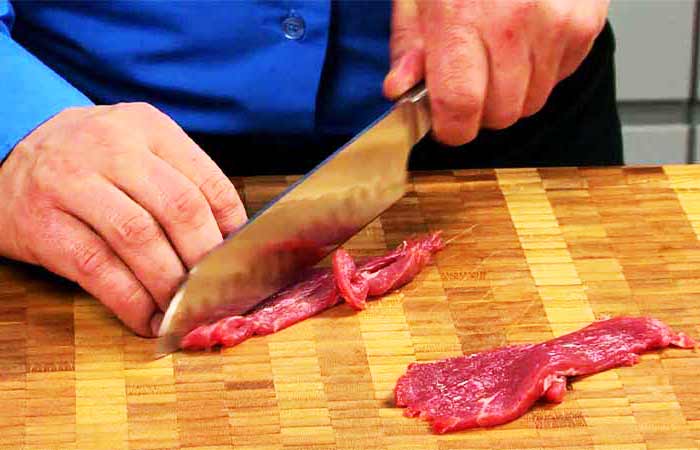
The reason you’d like to use a Santoku knife is probably to slice raw or cooked meats, vegetables, or other ingredients.
- To start slicing, apply a rapid downward motion while pulling its blade a little bit towards you while making the cuts.
- Make sure that you’re not cutting straight down without moving its blade towards you. This can bruise your ingredients instead of making clean cuts.
How to Mince Using Santoku
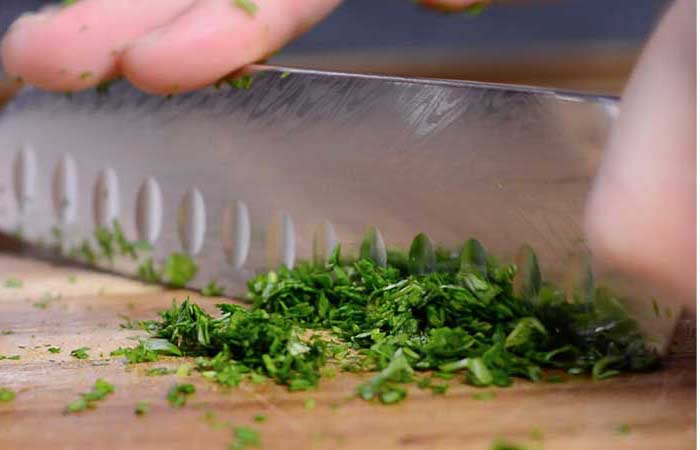
If you’re up for some recipes requiring minced garlic, herbs, or other ingredients involving finer cuts; you need to know the mincing techniques using the Santoku knife.
- If you’ve got the steady hand to cut the smallest possible pieces, the Granton edge of the Santoku should do it all.
- The sharpness, weight, and length of the blade will make it easier for you to cut the ingredient into thin pieces.
- Then you’ve to cut these thin strips crosswise for the finely minced product.
Maintenance Of A Santoku Knife After Use

How you care for your knife is a part of how well you use it. If you take good care of your Santoku Knife, it’ll stay sharp for a long time.
- Wash the Santoku knife after every use. You can hand wash it with warm water and cleaning soap. Use a gentle brush or soft cloth to clean the debris. Finally, wipe it off completely and dry it with a towel.
- Use a good knife block to store your Santoku. This will protect the knife from any unwanted damage.
- Sharpen the knife regularly using a good whetstone.
- Follow the guideline from the manufacturers.
Difference Between A Santoku and A Chef’s Knife
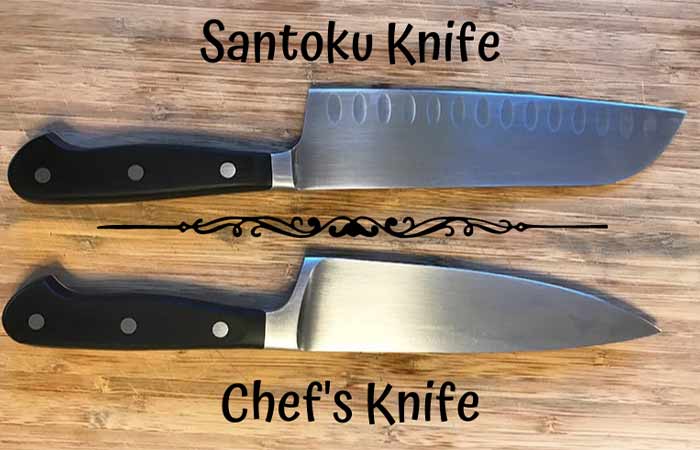
Although the Santoku and the Chef’s Knife are commonly used general-purpose kitchen knives for home and professional use, there are some differences. Let’s check out some of these key differences below.
| Santoku | Chef’s Knife |
| Originated in Japan | Originated in Europe: Germany/France |
| Wider sheepsfoot blade without a tip | Broad, upward curved blade that forms a tip |
| Thinner blade for finer slicing | Slightly thicker |
| Balanced weight and feels lighter | Heavier |
| Size varies from 5’’ to 7.9’’ | Size varies from 6’’ to 12’’ |
| Generally, no bolster | Has a bolster |
| Good for finer slices and scooping food off | Good for complex and versatile cuts |
How to Sharpen a Santoku Knife
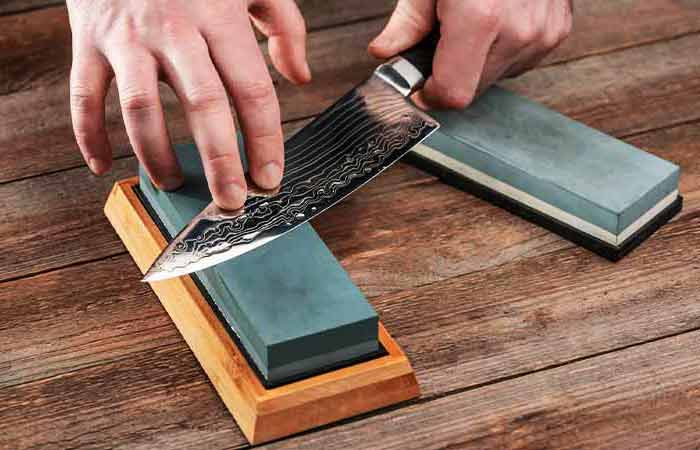
Like every other knife, Santoku will dull after repeated uses. All you need to do is sharpen it in a proper manner. If you follow the guide, you can restore its edge even without visiting a professional sharpener.
Since these knives come with a double bevel and Granton edge,you might feel the sharpening procedure is a little complicated. But it’s not as they don’t have any bolster.
- Firstly, know the specifications of your knife as the sharpening angles may vary.
- Then take a whetstone to sharpen your knife. It’s the best method to create a sharper knife edge.
- We recommend you not to use an electric home sharpener as it can destroy the Granton edge of your knife.
You can follow the steps below to sharpen your Santoku:
- Submerge and soak your whetstone in water
- Tilt the Santoku at the specified angle using the coarse side
- Smoothly run the knife up and down
- Make sure to cover the entire blade from its edge to its starting handle
- If the knife is double beveled, repeat the process on the other side
- Turn the stone to the finer side to repeat the process
- Wash thoroughly and allow it to dry
FAQs
What is a Santoku knife used for?
Santoku knife is mainly used to cut thin and finer slices of meat, vegetables, seafood, fruits, cheese, etc. It is the top choice for slicing, chopping, dicing, and mincing. Its wide blade also allows scooping food off the cutting board, into the pan.
What type of cutting board is the best for Santoku?
For Japanese knives like Santoku, the end-grain cutting boards make the best choice. They’re hard enough to withstand regular uses and soft enough to not damage the blade. The end-grain boards are more expensive than the edge-grain or bamboo-wooden boards.
Can I rock chop with Santoku Knife?
No, you can’t. Because the Santoku isn’t designed to rock but to slice. You need to get the chef’s knife to rock chop.
How wide is a Santoku Knife?
A Santoku knife is available in 5-inch (12.5 cm) width which is considered as the mini-Santoku. It’s used for many small to medium cutting jobs in the kitchen.
The larger 5.5-inch (14cm) version of the Santoku knife is considered the standard size and is the most widely used kitchen knife out there.
What is the best blade size for Santoku?
If you want a one-fits-all solution, the 7-inch blade makes the best choice as it can cut a wide variety of foods. On the other hand, if you have only the smaller ingredients to cut, the 5-inch size could make the best option.
Final Thoughts
Since you’re interested in using Santoku, this guide should help you know how to get started with a Santoku knife and how to use it in the right manner.
This knife is designed to deliver maximum results and is the most popular choice for professional and home kitchens. With proper use and care, it should be an effective cutting tool for a long time.



